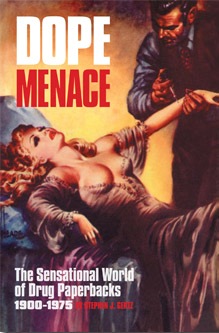For anyone with an interest in drugs, kitsch, and popular culture, "Dope Menace" is going to be a real pleasure -- and probably something of an education. Lavishly illustrated with more than a hundred pulp paperback book covers, many of them gloriously lurid, their cover text tawdry and sensational, the book offers a delicious, delirious excursion to the far shores of post-World War II pop culture, a place where the sordid mixed with the forbidden, and sexual anxiety -- or was it curiosity? -- permeated almost everything.

Gertz knows his pulp. A respected authority on antiquarian books, he also contributed to "Sin-A-Rama," an award-winning visual history of sleaze paperbacks from the 1960s. And he puts his knowledge on fine display here, not only with his lovely selection of cover art -- more on which later -- but also with a downright scholarly text that takes up about half of the book's first 60 pages.
Gertz's exposition is as revelatory as his collection of cover art is alluring. His text provides a capsule history of the golden era of pulp paperback publishing in the 1950s and 1960s -- some 243 million of those 25-cent pocket-sized paperbacks sold in 1952 alone -- when, long before the dawn of the Internet, the mass pulp market was a key means of informing (or misinforming) the great unwashed curious about things where cultural knowledge had been lost (drugs since the advent of drug prohibition) or suppressed (sex since forever).
In the 1950s, hard back books were sold at bookstores. But, available at countless newsstands, grocery and drug stores, anywhere an enterprising publisher or wholesaler could squeeze in a display rack, the pulps radically democratized knowledge about drugs, albeit vicariously, and sometimes, thanks to hack writers who knew nothing of which they wrote, with ridiculously ludicrous misinformation.
Like the Internet, the pulps can be seen as a transgressive medium for their time, one that allowed the spread of knowledge outside officially sanctioned avenues. And like the Internet, the emergence of the pulps in general, and dope and sex pulps in particular, excited the wrath of moral crusaders. Gertz opens the book with a 1952 quote from Congressman Ezekiel Gathings (D-Arkansas), who complained that the pulps appealed to "adults with low ethical standard" and were "a media for the dissemination of appeals to sensuality, immorality, filth, perversion, and degeneracy."
But that didn't stop publishers from cranking out dozens, perhaps hundreds, of dope pulp titles a year for decades. And the publishers, of course, were responding to an apparently insatiable demand for the tawdry tomes with lurid covers, hopefully featuring beautiful women in various states of drug-crazed undress.
Gertz's text is a grand tour of the dope pulp phenomenon, reaching back to early forebears like the drug "confessionals" of Fitz Hugh Ludlow and Alastair Crowley and the racist anti-opium novels of more than a century ago before plunging headlong into the morass of sin and sensuality of mid-century mass market America. We go from such figures as Willliam Burroughs, whose dope memoir "Junkie" got the classic dope pulp treatment, to those nameless hacks (Gertz names them and their pen names, but I won't) whose prose was sometimes so awful and misbegotten that you have to laugh out loud. And you get a detailed treatment of some of the more esteemed illustrators as well.
But it's the cover art that really sells this book. How can you resist such kitsch as: "Reefer Club. A glimpse into the lives of our lost generation," superimposed over a cover montage showing images of passed out women with smoke drifting over them. "The girl was a slave of marijuana -- Yet was she wholly bad?"
If you lay "Dope Menace" on your coffee table, you're going to end up with amused friends and a well-thumbed volume. And you're going to learn something in between the laughs.
I have to say a word about Feral House, the publisher of "Dope Menace." I first became aware of them sometime back in the early 1990s, when Feral House head Adam Parfrey published "Apocalypse Culture," a truly mind-bending compendium of pieces from the far fringes of the American wasteland. Since then, Parfrey and company have continued cranking out the weirdness. If titles like "Mexican Pulp Art," "Voluptuous Panic: The Erotic World of Weimar Berlin," "Death Scenes: A Homicide Detective's Scrapbook," "Lords of Chaos: The Bloody Rise of the Satanic Metal Underground," or "Porn and Pong: How Grand Theft Auto, Tomb Raider and Other Sexy Games Changed Our Culture" sound like they might appeal to you -- or for that matter if you're looking for a serious memoir like Anthony Papa's "15 to Life" (available from DRCNet as a premium) -- check out the Feral House catalog. This short list is just a taste.
This work by StoptheDrugWar.org is licensed under Creative Commons Attribution-ShareAlike 4.0 International
Add new comment